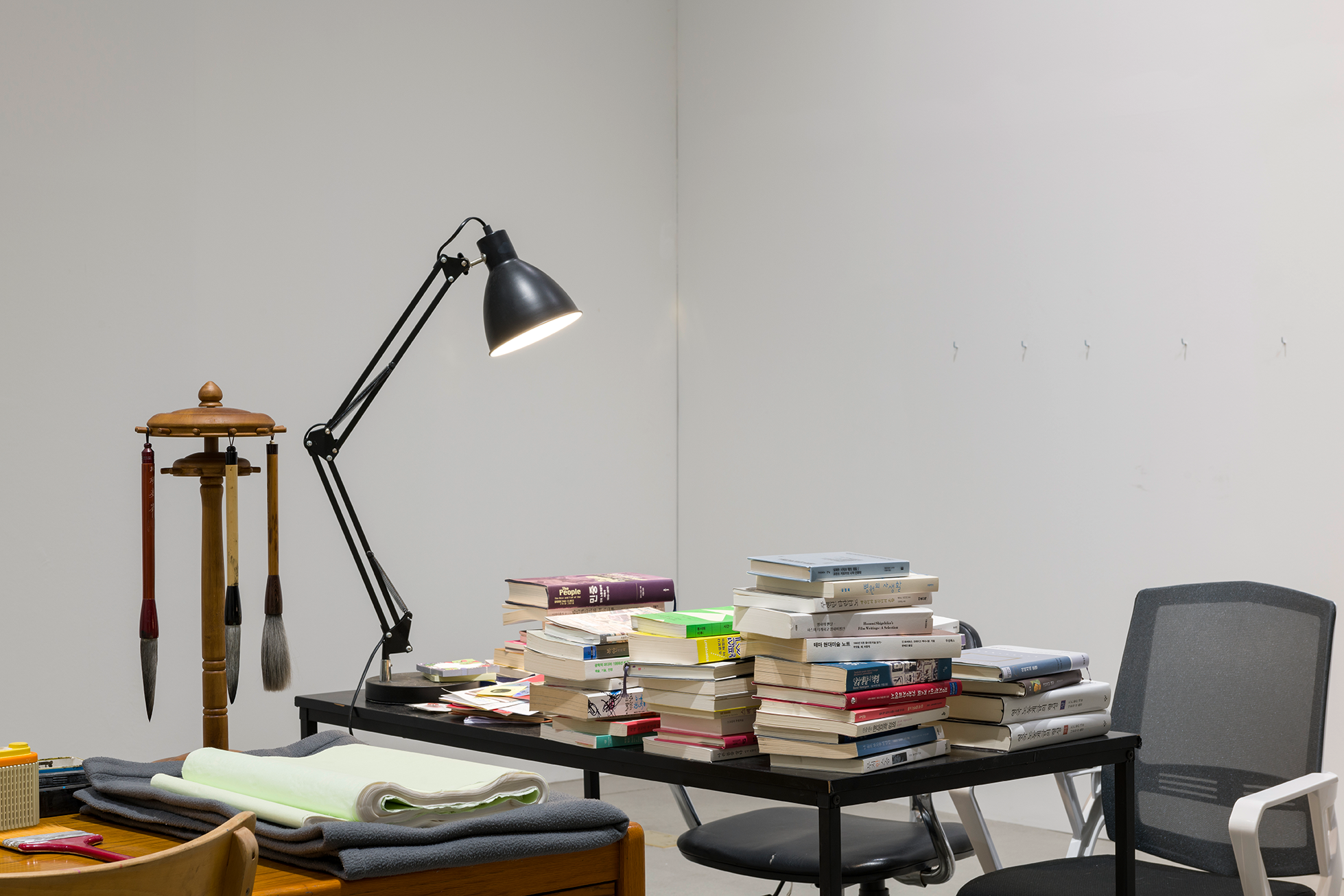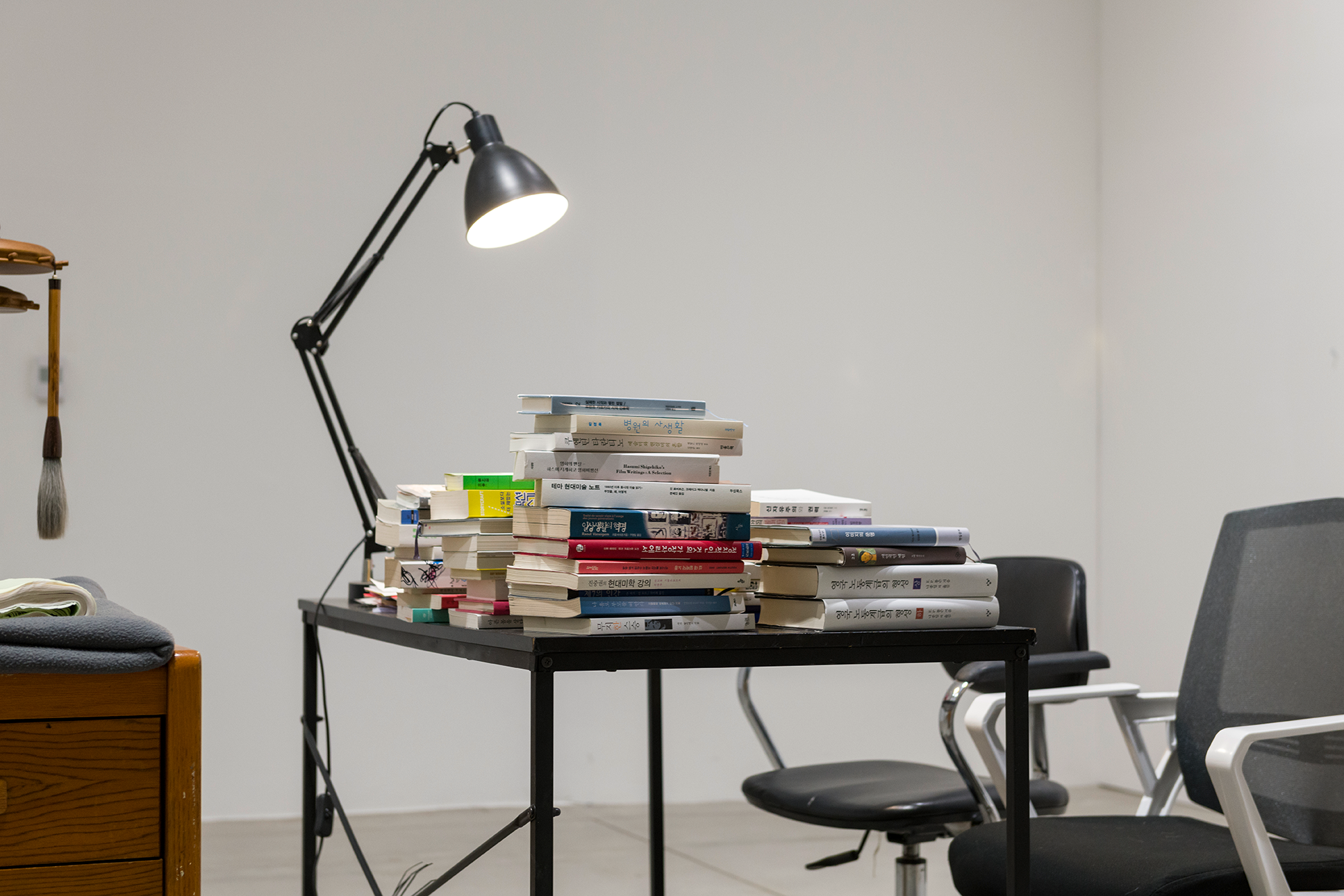Human Order (Desk of Calligraphy, Utility Organization, and Children)
2019
2 desks, 3 chairs, one low slotted angle rack, books, papers, one stand lamp, oriental brushes, inkstone, ink stick, one plant, one painted sheet of plywood
dimensions variable
︎︎︎Complexity of Ambivalence
The massive wave of modernization in the West and the dreamy notions of globalization in the 1990s universally transformed people’s lives into similar lifestyles. Even between people of different religions, social conventions, and culinary traditions, we all now lead similar everyday lives. Airports, schools, hospitals, shopping malls, militaries, politics, cities they look more or less the same in every country. Education is no exception, with the majority of people growing up in similar educational environments. In Korea, in Texas, in Tanzania, in Siberia, in Colombia’s Bogota, people go through similar education systems. By fifteen years old, one will have learned to understand algebra, read music, write papers on literature, and explain how metaphor works. For those who are more fascinated by academics than real life, the range and method of expression would be even broader. As we live our lives, we say things like, “I lost my passion for life,” or realize that “the subject-oriented ontology of ‘I’ tends to absorb ‘others’ into its realm and identify the two realms as one, ignoring the ‘otherness of others.’” In other words, we use language to exchange information and express what we feel to others, but we also use languages of varying form and meaning to communicate with strangers we do not know. The fact that language has evolved in the way it has proves that humans not only use language for face-to-face communication, but also that we have the capability to use imaginary and symbolic languages.
Understanding the whole, understanding the history of a community, understanding society, and understanding context are different from understanding details, understanding the everyday life of an individual, understanding family, and understanding text. Therefore, a person exists as a
part of the whole but as an individual at the same time. As we communicate to the rest of the whole, we also question ourselves. We write diaries about our everyday lives, and we also write our business plans for next year. We use metaphors to express our feelings, and we write thesis papers armed with analysis and logic. We use our private system of language when complaining about the slow buffering speed of videos online, but we shift to a public system of language when we try to explain concepts such as others, knowledge, video, data, and digital technology. The private realm of language is realistic, contemporary, and intuitive, but the public realm of language is symbolic, structural, temporal, spatial and logical. The fact that we utilize both realms to suit our needs suggests that some people prioritize everyday issues, while other invest greater interest in broader issues.
In the realm of art, there is one current that focuses on the “senses,” “aesthetics,” and “anti-art,” whereas the other focuses on the subjects of “reality” and “practice.” This opposition in art exists in the same way as idealism and materialism, the whole and its parts.
Two opposing concepts exist in this work. The work demonstrates that such dichotomous concepts do not merge with each other to create another new concept, but that despite the dichotomy each concept operates independently. These dichotomous concepts oppose each other, but at the same time imitate, antagonize, and ironically, love each other. This work is idealistic yet real, realistic yet imaginary, specific yet abstract, general yet detailed, collective yet individual. It presents the real desk of an individual, and at the same time, symbolizes the idea of site. It is simple yet complex, beautiful yet ugly. The work is neither a representation nor a work of non-art.
︎︎︎양가적 복잡성
서구의 근대화라는 큰 파도와1990년대 세계화라는 꿈같았던 개념은 전지구인의 삶과 인식의 형태를 비슷하게 만들었다. 이제 전지구인들의 삶은 종교가 다르고 관습이 다르며 음식이 달라도 거의 비슷한 형태로 진행된다. 공항도, 학교도, 병원도, 쇼핑몰도, 군대도, 정치(政治)도, 도시(都市)도, 모든 것이 비슷해 졌다. 교육도 예외는 아니어서 대부분의 사람들은 비슷한 교육 체계 아래서 비슷한 교육을 받으며 성장한다. 한국에서도, 미국 텍사스에서도, 탄자니아에서도, 시베리아에서도, 콜롬비아 보고타에서도 비슷한 교육을 받는다. 아마도 15세가 되면 대수학을 이해할 것이고, 음악 악보를 읽을 수 있고, 문학 수업에 대한 리포트를 작성하면서 은유에 대해 설명을 할 수 있을 것이다. 현실적 삶보다는 학교에서 가르치는 여러 교과목에 흥미를 느낀 사람이라면 다양한 표현 방법을 알고 있을 것이다.우리는 살아가면서 “난 내 인생에 애정이 없어.”라는 말을 하기도 하고 “인식 주체를 중심으로 하는 존재론은 ‘나’ 이외의 모든 ‘타자’를 ‘나’의 인식 안으로 끌어들이며 ‘타자의 타자성’을 무시하고 동일자의 영역으로 환원한다.”라는 말을 하기도 한다. 즉 우리는 정보를 교환하고 자신의 감각을 상대에게 전달하는 언어도 사용하지만 실제로 알지 못하는 타인과 소통하기 위해 다양한 의미의 언어를 사용하기도 한다. 언어가 발전했다는 것은 인간이 일상적이고 대면(對面)적 언어만 사용하는 것이 아니라 상상의 언어와 상징적 언어도 사용할 능력을 가졌다는 것을 말한다.
전체를 이해하는 것, 집단의 역사를 이해하는 것, 사회를 이해하는 것, 맥락을 이해하는 것은 세부를 이해하는 것, 개인의 일상을 이해하는 것, 가족을 이해하는 것, 텍스트를 이해하는 것과는 다른 일이다. 그래서 한 개인은 전체 속에 있기도 하면서 동시에 한 개인으로서도 존재한다. 전체에게 말을 건네면서도 스스로에게도 질문한다. 하루를 정리한 일기를 쓰기도 하고 내년도 사업 계획서를 작성하기도 한다. 자신의 감정을 표현하기 위해 비유를 사용하다가도 분석과 논리로 무장된 논문을 쓰기도 한다. 우리는 동영상 업로드가 잘 되지 않아 불평하는 것과 같은 사적인 언어체계를 사용하다가도 타인, 앎, 동영상, 데이터, 그리고 디지털이란 개념을 이해시키기 위해 공적인 언어체계로 전환한다. 사적인 언어는 일상적이고, 현실적이고, 동시대적이고, 직감적이나 공적인 언어는 상징적이고, 구조적이고, 시공간적이며, 이성적이다. 우리가 이렇게 사적인 언어와 공적인 언어를 나누어 사용한다는 것은 어떤 이들은 현실적인 문제를 중요시 한다는 것이고 어떤 이들은 거시적인 문제에 대해 흥미를 갖는다고 볼 수 있다.
미술이라는 영역에서는 ‘감각’에 대한 것, ‘미’에 대한 것, ‘반예술’에 대한 것에 관심이 있는 부류가 있다면, 다른 지점에서는 ‘현실’과 ‘실천’이라는 주제로 작업하는 부류가 있다. 관념론이 있다면 유물론이 있고, 전체가 있으면 그 안에 부분도 있듯이 미술에서도 두 가지 대립적인 관계가 존재한다.
이 작품은 두 가지 대립적인 개념이 존재한다. 이원적으로 나뉘어진 개념을 한 곳에서 섞여 새로운 개념이 발생하는 것이 아니라 이원적 구분에도 불구하고 각각의 개념이 독립적으로 작동하고 있음을 말한다. 이러한 양가적 개념은 대립하는 개념이면서도 서로가 서로를 닮아가고 적대하며 모순적으로 사랑한다. 이 작품은 관념적이면서 실재적이고, 현실적이면서 상상적이며, 구체적이면서 추상적이고, 전체적이면서 세부적이고, 집단적이면서 개인적이다. 이 작품은 한 개인의 실재적 책상이자 현장(現場)의 상징이다. 단순하면서 복잡하고 아름다우면서 추하다. 물론 이 작품은 재현(再現)이 아니고 비미술(非美術)도 아니다.










